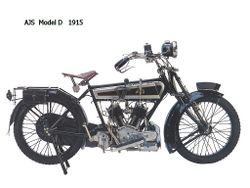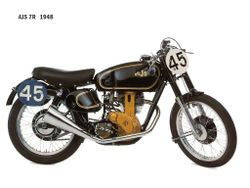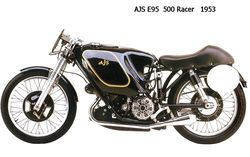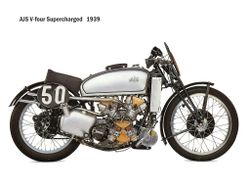Difference between revisions of "AJS"
(→Models) |
|||
| Line 27: | Line 27: | ||
==Models== | ==Models== | ||
*[[AJS 16MS|16MS]] | |||
*[[AJS 16M|16M]] | |||
*[[AJS 7R|7R]] | *[[AJS 7R|7R]] | ||
*[[AJS ISDT|ISDT]] | *[[AJS ISDT|ISDT]] | ||
Revision as of 21:46, 25 April 2019
AJS was founded by Albert John Stevens (hence the name) in Wolverhampton around 1900. AJS won the Junior TT in 1914, but their greatest racing accomplishments came later, memorably when Les Graham won the first ever 500cc world championship on the Porcupine twin in 1949. By 1931 AJS held 117 motorcycle world records.
History
Joseph Stevens (senior) was born in Wednesfield in 1856 and became a self employed engineering blacksmith in 1874. His company was called J. Stevens & Co. with premises in Cross Street, Wednesfield. He undertook all kinds of metalwork from making horseshoes, parts for a horses harness and bridle, to repairing or making garden tools. He also worked on such diverse things as bicycles and locks, and soon gained a reputation as a highly skilled craftsman. Joe and his wife had nine children. All of them in time would be involved in the family business.
Joseph's eldest son Harry joined him in the business and they moved to premises in Tempest Street near Wolverhampton town centre, where they were soon joined by Joseph's third son Joe junior. Harry soon acquired his fathers engineering skills and began to design all kinds of machines and tools for use in the lock industry. Joseph acquired a small American, 'Mitchell' single cylinder, 4 stroke petrol driven engine for use at the works. It was poorly built and unreliable but interested Harry greatly. He decided that he could do better and set about designing and building his own engine. Rough castings were obtained from a company at Derby.
These were machined by the two brothers who built the engine in their spare time. It was completed late in 1897 and was an instant success. It outperformed the 'Mitchell' engine in every way, being reliable and efficient, and delivered about 1.75h.p. Harry and his father were quick to realise that a large market existed for reliable petrol engines for use in industry. They decided to manufacture engines and set up the Stevens Motor Manufacturing Company in 1899.
This was to have far reaching consequences for Wolverhampton industry. Thanks to Harry who was the mechanical genius of the family, Clyno would eventually move here to produce motorcycles and cars, Sunbeam would start to produce engines of its own, based on one of Harry's designs, and of course A.J.S. came along 15 years later. One wonders if Wolverhampton would have been such a large vehicle manufacturer without Harry starting it all. He is certainly one of the unsung heroes of the town.
Merger with Matchless
In 1931 AJS was taken over by Matchless of London. The merged firms formed Associated Motor Cycles (AMC) in 1938, but the AJS and Matchless marquees were retained to retain their owner loyalty. This resulted in the bikes having cases of split personalities in which the Matchless version was the same bike differing only in paint color, badges, and exhaust systems. When civilian production resumed during 1946 there was little to distinguish between the Matchless G3L and G80 models and the AJS 16 and 18 variants other than the position of the magneto and badge on the tank.
With an emphasis being placed on production, the company concentrated their efforts on the singles which were largely the same as the wartime G3L except for color and the displacement of the larger models. However, their experience with hydraulic suspension gained during the war years resulted in the manufacture for the 1949 domestic market models ( there is some evidence of machines being built with a sprung frame from 1947 onwards for export) of a pivoted fork frame which was used on both the singles and the recently introduced twin. The new frame, equipped with slender damper units of AMC's own design, was superior to their rivals plunger based systems both in terms of road holding and comfort. The next major revision to the singles range occurred during 1951 when the original suspension units were replaced with the distinctive "jampot" units.
Detail revisions occurred over the next four years, a new Burman gearbox had been introduced during 1952 and auto advance had been added during 1954 together with a full width front hub, which was revised for 1955 and joined by a matching rear one. For 1956 a new frame was introduced with a restyled, long thin oil tank and matching toolbox which also housed the battery resulting in what is arguably the best looking of the "heavyweight" singles family and the only year that the full width alloy hubs, Jampots and long toil tank/toolbox coincided.
The most popular AJS racer was the single cylinder 350cc 7R, which was commonly known has "Boy Racer". It was first introduced in 1948, the 7R was hugely successful was later enlarged to 500cc with the Matchless G50.
Model 30
Most of AJS's roadsters were less inspiring singles and parallel twins such as the Model 30, with its 600cc engine that had almost square dimensions giving it a smoother ride than comparable models. With peak power producing 33bhp the twin was capable of cruising at 70mph. Combined with predictable handling, this made for a relaxed comfortable bike suitable for traveling long distances. The Model 30 was also well-made, reliable, and economical, unfortunately such attributes were not enough to keep AJS in business. Poor sales led to AMC becoming part of Norton Villiers in 1967. Some AJS bikes were then continued incorporating Norton parts, but they were not successful and the factory ceased production shortly afterwards.



